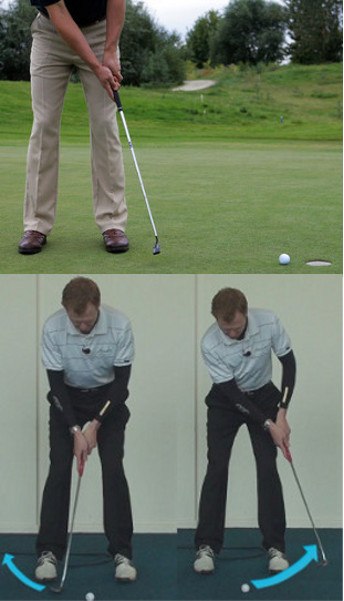 “If you're going to make a mistake, make it going full speed.”
“If you're going to make a mistake, make it going full speed.”
That's what football coaches teach their players, but it applies to golf as well. A timid approach spells trouble in both sports.
In golf, a hesitant swing or stroke is usually caused by indecision. Maybe you're not sure you've picked the right club, or you're concerned about hitting the ball too far. A looming hazard can make a coward of the burliest golfer. There's no way to banish uncertainty from your golf game. It comes with the territory.
You can, however, resolve to swing with certainty. That is, once you've decided how to play a shot, commit to it 100 percent.

Swing, chip, pitch and putt with conviction and you'll curtail the tendency to decelerate, lift the head early, or baby the ball. Tentative attempts lead to fat and thin contact, pulls, pushes and all manner of poor results.
It's almost impossible to play a good bunker shot with a cautious swipe. Committing to each shot won't guarantee success every time. But at least your mistakes will be made with all-out effort.

Caution – Tentative Mentality Causes Bad Golf Shots
When searching for ways to improve their performance on the course, most golfers turn to the physical side of the game. After all, it only seems obvious that improving on your technique will lead to lower scores – and it certainly can do just that. However, looking only to the physical side of your game means you will be ignoring half of the golf puzzle entirely. The mental game is incredibly important in terms of your overall performance and the scores you are capable of shooting, so it should be targeted for improvement as well. In fact, if you can teach yourself to use your mind properly during a round of golf, you just might be surprised to find how well you can play with the swing you already have.
Teaching the mental side of the game is significantly harder than teaching physical technique because there is no way to see what a golfer is thinking. To diagnose a problem within their technique, a teaching professional can simply record a video, watch it back in slow-motion, and point out the errors. That doesn't work with the mental game. Only the golfer knows what is going on in his or her mind, and it is up to that individual to make changes. Instruction, like that contained below, will only be helpful if the golfer is willing to be honest about how their mental can be improved.
In this article, we are going to address one specific mistake that is frequently make in the mental game – having a tentative attitude. If you stand over the ball feeling unsure about your swing or the target you have picked out (or anything else), your chances of success will immediately drop significantly. Confidence is one of the most important elements in the entire game, and feeling tentative is the opposite of feeling confident. A tentative golfer is one who will struggle to take their game from the range to the course, and they will specifically struggle under pressure. On the other hand, a golfer with plenty of confidence and an aggressive mentality will tend to rise to the occasion more times than not, hitting their best shots when it matters most.
As you can imagine, your favorite golfers on the PGA Tour understand the importance of mentality as well as anyone. There is an incredible amount of pressure when you have to perform at a high level week in and week out just to keep your job, so pro golfers work hard to maintaining the right mentality from the first shot to the last. In fact, it is often the ability to maintain a good attitude that separates the top players from the rest of the field. After all, every player at that level has the ability to hit beautiful shots and to roll great putts – the differences in their scores usually boils down to who can keep their mind in the right place for the longest period of time.
All of the instruction below has been written from the perspective of a right handed golfer. If you happen to play left handed, please take a moment to reverse the directions as necessary.

The Negative Outcomes
Before working on how you can fix the problem of a tentative mentality in your game, it is first important to understand what kind of negative outcomes can arise as a result of this issue. The doubts that roll around in your mind as you prepare to swing the club will usually be manifested in the actual results of your shots, so you need to understand how to connect one to the other. Once you see how closely your mental game is tied to the physical side of the equation, you will have all the motivation you need to 'clean up' the way you think.
Each of the problems in the list below could potentially be caused by a tentative frame of mind.
- Hitting the ball fat. This is one of the most-common outcomes when you make a tentative golf swing. As the club heads down toward the ball, you need to be moving your entire body confidently through the hitting area – and if you don't, it will be likely that the result is a fat shot. Obviously, catching your shots fat is never a good outcome, as the ball will almost certainly come up short of the target as a result. You have to keep the speed up in your downswing in order to catch the ball before hitting the turf, and that will never happen if you are swinging tentatively. One of the biggest motivations to work on your mindset in the swing should simply be to enable yourself to hit the ball cleanly time after time. Clean contact is one of the main keys to playing well out on the course, and clean contact is a direct result of a high level of confidence.
- Coming up short. Even if you do manage to hit the ball cleanly with a tentative swing, that clean contact still might not be enough to get the ball all the way to your target. For example, imagine that you normally hit your seven iron 150 yards when you make a good swing. So, when you run into a 150-yard approach shot on the course, you naturally pull your seven iron from the bag. However, since there is a hazard around the green, you make a tentative swing through impact (although you still make good contact). The hesitation and doubt in your swing can easily cost you a few miles per hour of swing speed – and now your seven iron may only fly 140 or 145 yards. That subtle difference is easily enough to cause your shot to miss the green, and you might even wind up hitting the ball into the hazard that you were worried about in the first place. Only if you can keep that tentative thinking out of your swing will you be able to create maximum clubhead speed in order to reach your target time after time.
- Yips in the short game. Just the sight of the word 'yips' makes most golfers shudder, and for good reason. The yips can quickly tear your short game apart, as they make it nearly impossible to handle even the easiest of short shots. You probably associate the yips with short putts, but this problem – which is tied to a tentative attitude – can actually affect you on long putts, chip shots, bunker shots, and more. If you struggle to get yourself into a positive frame of mind while getting ready to hit short shots, you will always be at risk for the yips.
There are many more problems that can potentially pop up as a result of a tentative attitude, but the three points on the list above should be enough to help you understand the seriousness of this problem. Without a positive attitude and an aggressive frame of mind, it will simply be hard to play golf at a high level. Whether you are trying to compete in tournaments at your local club or you just want to beat your own personal best, there is no room for a tentative mindset. Commit yourself to defeating this mental game 'enemy' and you will be on your way toward a better future on the links.

The Cause of Tentative Thinking
The human brain is incredibly complex, but sometimes it is rather easy to understand. In this case, it isn't actually all that hard to understand why golfers fall into the habit of thinking tentatively on the course. As you know, golf courses are designed with a variety of obstacles and hazards meant to punish your bad shots. Some of these dangers are more penalizing than others, but you want to avoid all of them if you are going to stay on track for a good score. However, as you stand over the ball waiting to swing, it is only natural to be thinking about the bad places that your ball could end up. As a result, you may swing tentatively while thinking more about the hazards than the target itself.
Your likelihood of making a tentative swing is directly related to the severity of the hazard in front of you. For instance, if the green is only guarded by a shallow sand bunker with no real lip to speak of, you probably aren't going to be all that afraid. After all, even if you do hit the ball into the bunker, you should be able to get out and save your par with relative ease. On the other hand, if the green is guarded by a large pond waiting to collect your golf ball if you miss-hit the shot, you are going to have more reservations about the swing. You may doubt your ability to clear the water successfully, and you may make a tentative swing in turn. Knowing that a poor shot will cost you at least one stroke (and a golf ball, as well), you will be at risk of making a scared, cautious swing that severely harms your chances of finding the target.
This is one of the reasons why golf is among the hardest games in the world. To succeed, you need to make fearless swings, but the hazards that are in front of you are precisely what is causing fear in the first place. The challenge, then, is clear – you have to make confident swings regardless of the circumstances. Whether you are facing an easy target or one that is wrought with danger, your approach to the swing needs to be exactly the same. Only when you can make confident swings in the face of danger will you be able to handle anything the course throws at you.
Of course, this is a habit that is easier understood than it is changed. While you might know that you need to be confident when you swing the club, it is another thing entirely to actually carry that confidence with you onto the course. As the saying goes, 'if it was easy, everyone would do it'. Golf is known as a hard game in large part because of the mental challenge that it presents. Getting over this significant hurdle is possible, but it isn't going to be easy. It is important to understand that nobody successfully remains confident over 100% of their shots. Even the best players in the world have doubts from time to time, and even they will make tentative swings occasionally when they can't quite summon the confidence to be aggressive. So, you shouldn't allow one tentative moment to totally undermine your belief in yourself. Stay positive as often as possible, expect to make great swings, and keep working toward a future filled with fewer and fewer tentative moments.

Building Good Habits
The problem of making tentative swings is not one that you can address directly. In other words, you can't just tell yourself to 'think positively', and have that be the end of it. Well, you can try to take that approach, but it is unlikely to be successful. Instead, you are going to need to work around the problem by implementing a number of steps into your game that can help to breed confidence and self-belief. In other words, you are going to design an 'environment' that will promote a good attitude, and hopefully you will be so busy executing your plan that you won't even have time to get nervous or tentative with regard your swing.
The list below includes a number of good habits that you can attempt to use to make progress on this point. Use as many of the following points as you see fit until you feel that tentative swings are a thing of the past.
- Focusing on the target. While you are always going to be aware of hazards that are in play for a given shot – and you need to be aware, so you can make smart decisions – ultimately your focus should remain on the target itself. Whatever target you have selected for a given shot, whether that is the hole or a spot elsewhere on the course, you should be thinking about that target alone when making your swing. As long as you execute the swing, it won't matter that there are hazards nearby, because you will put your ball safely on the grass. Get into the habit of focusing on the target during your range sessions and then carry that line of thinking out onto the course.
- Choose the club that gives you confidence. On any given shot, there is more than one club that you can use to reach the target. Most shots can be handled successfully with two or three different clubs, depending on how you want to play the shot. With that in mind, you should always go with the one that instills the most confidence in your mind. This should be mostly a 'gut feeling' decision. Rather than relying strictly on analysis of distance, elevation, wind, etc., you should also be listening to your 'gut' and going with the club that you trust in the situation. When you stand over the ball knowing you have a club in your hands that you can trust, you will be much more likely to make a confident swing.
- Stick with your routine. One of the most important things you can do to avoid tentative swings is to stick with your pre-shot routine. You should already have a well-defined routine in place, and if you don't, make that one of your top priorities. Once you know what your routine is going to be before each shot, do your best to stick with it precisely. It doesn't matter if you are hitting a warmup shot on the range or a crucial approach on the 18th hole, your routine should remain the same. That consistency is going to give you peace of mind during the swing, as your body will feel comfortable with the process. Nearly every professional golfer in the world uses some form of pre-shot routine, and you should be doing the same.
- Play more often. Quite simply, there is nothing like experience for the purpose of putting bad thoughts out of your head. When you play more golf, you will have the opportunity to succeed in more and more circumstances – and those successes will go a long way toward allowing you to have confidence in the future. For example, if you are facing a tough approach shot over water, you can look back on another similar shot you have hit successfully in order to give yourself the belief you need to pull it off. However, if you haven't hit any shots like that in recent memory, it may be hard to convince yourself that you can do it.
The goal here should be to put yourself in a position to succeed mentally as often as possible. There will still be the occasional shot where you can't quite get your mind right, and that's okay. As long as you are using the tips listed above to create a positive frame of mind as often as possible, you can be sure that you are on the right track. Of course, if your scores start to come down as a result of your improved thinking, that will only reinforce the notion that you are taking steps in a positive direction.

Dealing with Short Putts
The issue of short putts and the yips was mentioned earlier, but it needs to be discussed more closely before the end of this article. Many amateur golfers – and even some pros – struggle with short putts, which is a frustrating experience to say the least. Hitting two or three good shots on a hole only to waste them with a missed short putt can drive even the most patient golfer up a wall. To get your game on track and to shoot the best scores possible, you simply have to make the majority of your short putts.
Finding the right mindset to use over your short putts can be a bit tricky. Yes, you want to be confident, but overconfidence can result in hitting your putts too hard – which is a dangerous game to play. Some golfers like to knock their short putts in aggressively, but doing so opens you up to the risk of sending the ball too far past the cup. You need to feel confident yet relaxed and comfortable with the stroke that you are going to use. Getting in the right frame of mind over a short putt is a bit different from trying to do the same over a full swing.
To give yourself the best possible chance to make the putt, you want to have a specific target in mind so you can focus your efforts on hitting that target. You might be surprised to learn that the target you use for your short putts should not actually be the hole itself. Instead, you should be picking out a point between your ball and the hole that you are going to use as a target. If you roll the ball over this aim point, you should see the ball fall in the cup nearly every time. Using this plan will take some of the pressure off of your stroke – since you won't be thinking solely about the hole itself – and you will likely find that your confidence quickly grows. Also, since you are going to be looking at a point short of the hole, you will be less inclined to hit the ball too hard.
Thinking tentatively during a round of golf is almost always going to lead to negative outcomes. While you don't want to be overconfident or overaggressive, you also need to believe in yourself and your ability to hit good shots. Use the tips in this article to work on improving your mindset until you are able to find a nice balance in the way you approach the game. While it might not seem as important as the technique of your swing, you may be surprised to find just how much a quality mental game can improve your overall play.






